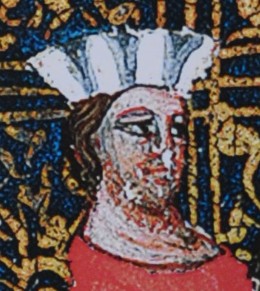Related Research Articles

Lotharingia was a medieval successor kingdom of the Carolingian Empire. It comprised present-day Lorraine (France), Luxembourg, Saarland (Germany), Netherlands, most of Belgium, and Germany west of the Rhine. It was named after King Lothair II, who received this territory as his share of the Kingdom of Middle Francia which his father, Lothair I, had held.
An elective monarchy is a monarchy ruled by a monarch who is elected, in contrast to a hereditary monarchy in which the office is automatically passed down as a family inheritance. The manner of election, the nature of candidate qualifications, and the electors vary from case to case. Historically, it was common for elective monarchies to transform into hereditary ones by repeated election of the previous rulers' children, or for hereditary monarchies to acquire elective or semi-elective succession laws, particularly following dynastic crises.

A pretender is someone who claims to be the rightful ruler of a country although not recognized as such by the current government. The term may often be used to either refer to a descendant of a deposed monarchy or a claim that is not legitimate.

Oldřich, a member of the Přemyslid dynasty, was Duke of Bohemia from 1012 to 1033 and briefly again in 1034. His accession to the Bohemian throne marked the start of a phase of stability after a long period of internal dynastic struggles. Under his rule, the Moravian lands were reconquered from Polish occupation.
A cadet branch consists of the male-line descendants of a monarch's or patriarch's younger sons (cadets). In the ruling dynasties and noble families of much of Europe and Asia, the family's major assets have historically been passed from a father to his firstborn son in what is known as primogeniture; younger sons, the cadets, inherited less wealth and authority to pass on to future generations of descendants.
David VIII, from the Bagrationi dynasty, was king (mepe) of Central and Eastern Georgia in 1292–1302 and 1308–1311.

Albert II, Duke of Mecklenburg was a feudal lord in Northern Germany on the shores of the Baltic Sea. He reigned as the head of the House of Mecklenburg. His princely seat was located in Schwerin beginning in the 1350s.

Artaxias II, also known as Artaxes II and Artashes was a prince of the Kingdom of Armenia, member of the Artaxiad dynasty and King of Armenia from 34 BC until 20 BC.

The Veleti, also known as Veletians, Wilzi, Wielzians, and Wiltzes, were a group of medieval Lechitic tribes within the territory of Western Pomerania, related to Polabian Slavs. They had formed together the Confederation of the Veleti, also known as the Union of the Veleti, a loose monarchic confederation of the tribes. Said state existed between the 6th and 10th centuries, after which, it was succeeded by the Lutician Federation.

The Duchy of Saxe-Lauenburg, was a reichsfrei duchy that existed from 1296 to 1803 and again from 1814 to 1876 in the extreme southeast region of what is now Schleswig-Holstein. Its territorial center was in the modern district of Herzogtum Lauenburg and originally its eponymous capital was Lauenburg upon Elbe, though the capital moved to Ratzeburg in 1619.

Svatopluk the Lion was Duke of Bohemia from 1107 until his assassination in 1109. His rule was overshadowed by the fierce conflict around the Bohemian throne in the 12th century.

Wolin is a town in northwestern Poland, situated on the southern tip of the Wolin island off the Baltic coast of the historic region of Western Pomerania. The island lies at the edge of the strait of Dziwna in Kamień County, West Pomeranian Voivodeship.
The most important phenomenon that took place within the lands of Poland in the Early Middle Ages, as well as other parts of Central Europe was the arrival and permanent settlement of the West Slavic or Lechitic peoples. The Slavic migrations to the area of contemporary Poland started in the second half of the 5th century AD, about a half century after these territories were vacated by Germanic tribes fleeing from the Huns. The first waves of the incoming Slavs settled the vicinity of the upper Vistula River and elsewhere in the lands of present southeastern Poland and southern Masovia. Coming from the east, from the upper and middle regions of the Dnieper River, the immigrants would have had come primarily from the western branch of the early Slavs known as Sclaveni, and since their arrival are classified as West Slavs and Lechites, who are the closest ancestors of Poles.[a]

The Silesian Piasts were the elder of four lines of the Polish Piast dynasty beginning with Władysław II the Exile (1105–1159), eldest son of Duke Bolesław III of Poland. By Bolesław's testament, Władysław was granted Silesia as his hereditary province and also the Lesser Polish Seniorate Province at Kraków according to the principle of agnatic seniority.

The Oghuz Yabgu State or Oghuz ili was a Turkic state, founded by Oghuz Turks in 766, located geographically in an area between the coasts of the Caspian and Aral Seas. Oghuz tribes occupied a vast territory in Kazakhstan along the Irgiz, Yaik, Emba, and Uil rivers, the Aral Sea area, the Syr Darya valley, the foothills of the Karatau Mountains in Tien-Shan, and the Chui River valley. The Oghuz political association developed in the 9th and 10th centuries in the basin of the middle and lower course of the Syr Darya and adjoining the modern western Kazakhstan steppes.

Pomerania during the Early Middle Ages covers the History of Pomerania from the 7th to the 11th centuries.

The Lutici or Liutizi(known by various spelling variants) were a federation of West Slavic Polabian tribes, who between the 10th and 12th centuries lived in what is now northeastern Germany. Four tribes made up the core of the federation: the Redarians, Circipanians (Circipani), Kessinians and Tollensians (Tholenzi). At least in part, the Lutici were a continuation of the Veleti. In contrast to the former and the neighboring peoples, the Lutici were not led by a Christian monarch or duke, rather power was asserted through consensus formed in central assemblies of the social elites, and the Lutici worshipped nature and several deities. The political and religious center was Radgosc.
Liub, also known as Lub, was a grand prince of the Confederation of the Veleti, ruling from 810 to 823. He was the eldest son, and successor, of Dragovit. He had two sons, Milegast, and Cealadragus, with Milegast, as the eldest son, succeeding his throne.
Cealadragus was a prince of the Confederation of the Veleti. He was the second son of Liub. In 823, his brother, Milegast, who, at the time, was a ruler of the Veleti, was deposed, with Cealadragus replacing him. It is unknown how long Cealadragus ruled.
References
- 1 2 3 Kazimierz Wachowski, Gerard Labuda: Słowiańszczyzna zachodnia. Poznań: Wydawnictwo Poznańskiego Towarzystwa Przyjaciól Nauk, 2000, p. 67. ISBN 9788370632717. (in Polish)
- 1 2 3 Słownik starożytności słowiańskich, vol. 3, part 1, Wrocław, 1967. (in Polish)
- 1 2 Jerzy Strzelczyk, Po tamtej stronie Odry. Dzieje i upadek Słowian połabskich. Warsaw: Ksia̜żka i wiedza, 1968, p. 58. (in Polish)
- 1 2 3 Christian Hanewinkel: Die politische Bedeutung der Elbslawen im Hinblick auf die Herrschaftsveränderungen im ostfränkischen Reich und in Sachsen von 887–936. Politische Skizzen zu den östlichen Nachbarn im 9. und 10. Jahrhundert . Münster, 2004, p. 64f. (in German)
- ↑ Paval Urban: Staražytnyja lićviny: mova, pachodžańnie, etničnaja prynaliežnaść. Miensk, 2001. p. 47. (in Belarusian)